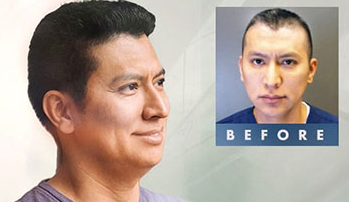Take a look at the very early growth in the first photo below, which reflects the first wave of growth following a hair transplant procedure of 2730 grafts. The new short hairs are easily covered by the hair from behind. When combed forward, the new hair blends with the old hair nicely. I’ve also included the before photo and a photo from 2 weeks after his procedure, just to be complete and so that you can get the full scope of what was done. Some of the short newly transplanted hairs have already fallen out and others that appear to be pointing the wrong way are actually about to fall out. Click the photos to enlarge.
5 months after procedure:
2 weeks after procedure:
Before procedure:
For an example of a past patient with similar results (but further along), please see radio host Steve Hartman‘s results. I’ve posted 3 photos of Steve below — the first photo is before the procedure, the middle photo is at the 5 month mark after his procedure, and the photo on the right is at around 14 months post procedure. I apologize that the angles are slightly different, but they illustrate the point that the above patient still is in the early stage and has a lot to look forward to. Click the photos to enlarge.


